
Julien Berthier
Nils Guadagnin
Marie Lorenz
Marc Quinn
Žilvinas Kempinas
Fujiko Nakaya
Shiro Takatani
Robert Breer
Ebru
Mungo Thompson
Andrea Zittel
Thom Kubli
Li Wei
Rafael Lozano-Hemmer
Trevor Plagen
Misha Kahn
Philippe Parreno
Ahmet Ögüt
Robert Smithson
Desmond Leung
KATSU
Vincent Leroy
Object Design League
Azuma Makoto
_____________
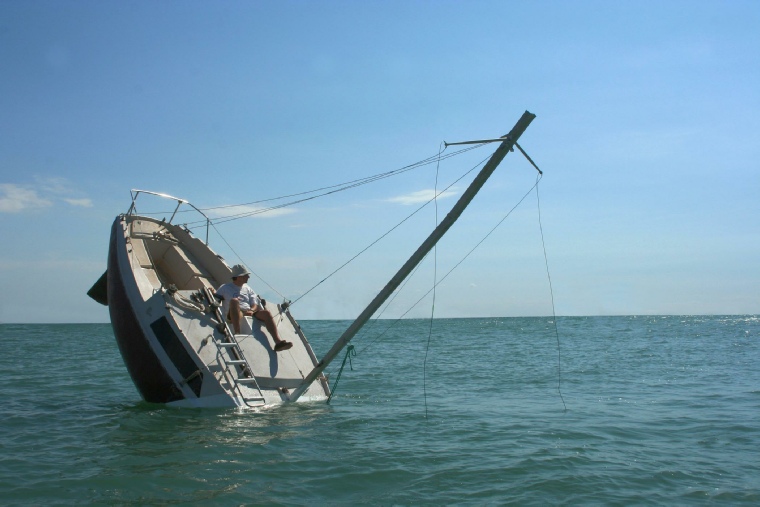
‘Artist and designer Julien Berthier has been sailing around the globe in “Love Love”, a weird ship that looks like it’s about to sink. He actually cut a sailboat in half, sealed it with fiberglass and fitted it with two motors, which make it fully functional, despite its capsizing look. The 35-year-old says his ever-sinking sailing craft is perfectly safe and easy to maneuver, especially in calm waters. He admits he has put the coast guard and harbor masters on full alert a few times, after people alerted them about a sinkings ship. Berthier, who says he “wanted to freeze the moment just a few seconds before the boat disappears, creating an endless vision of the dramatic moment”, has sailed his sinking boat on many trips through famous harbors like London’s Canary Wharf, and France’s Normandy.’ — Propaganda
_____________


‘French artist Nils Guadagnin’s “The Hoverboard” is a project born in 2008 for an exhibition named “Back To the future”. This work is a copy of the hoverboard from the movie Back to the Future II. Integrated into the board and the plinth is an electromagnetic system which levitates the board. A laser system stabilises the object in the air. “In the making of this work, I was thinking about different ways of presenting sculpture. In fact it’s a reflexion on the multiple possibilities of how to give a sculpture full spatial autonomy,” explains Guadagnin.’ — newslite.tv
____________
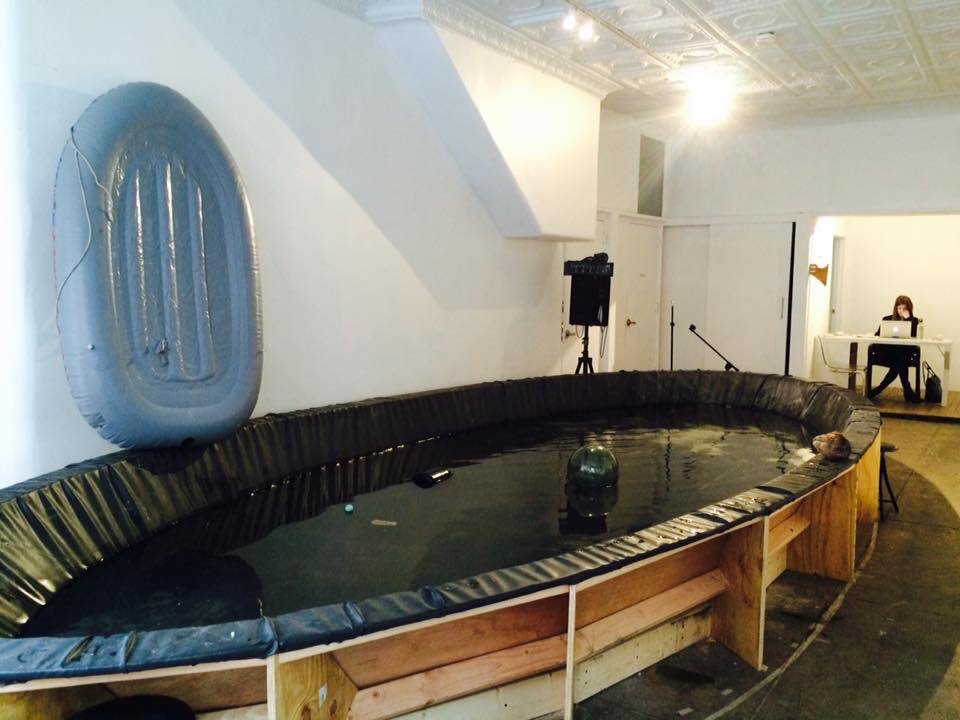


‘The first thing that comes to mind when you walk into Marie Lorenz’s exhibit Flow Pool at Recess in SoHo is a very neglected backyard pool. The pool is covered with a black tarp and the water is teeming with debris — things Lorenz found at the Jamaica Bay. According to the press release by Recess, “Flow Pool is a two-month long project that proposes the titular structure as a site of investigating questions ranging from the practical to the poetic.”’ — Not Your Chelsea Art
____________


‘marc quinn’s immense artwork “planet” 2008) is a seven month old sleeping child fabricated from painted bronze and steel, designed to give the impression of being weightless and suspended in mid-air – despite the fact it weighs seven tons and 10 metres in length, rendering it an engineering feat.’ — designboom
_________________
‘Somehow, the air currents created by two industrial-strength fans turn the two loops of videotape in Žilvinas Kempinas’s Double O into a living, dancing sculpture, performing tirelessly for hours. Double O is very much a drawing in space, a mass of lines activating the real world rather than a two-dimensional surface.’ — MoMA

____________


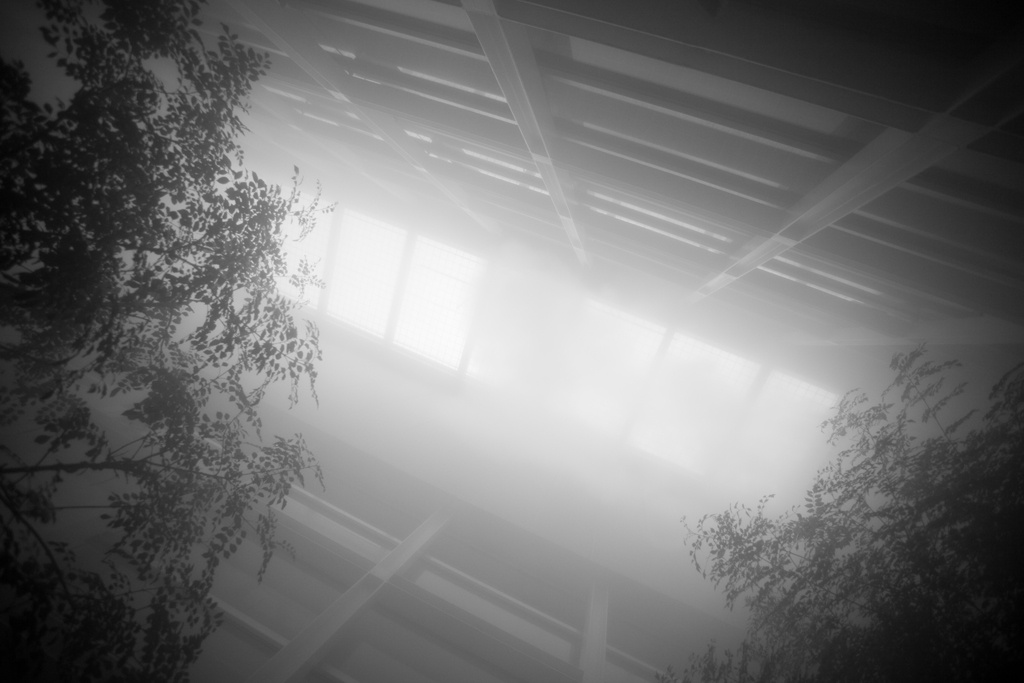
‘Like a pair of folding screen paintings, “CLOUD FOREST Patio A” and “CLOUD FOREST Patio B,” the collaboration of Fujiko Nakaya’s “Fog Sculptures” and Shiro Takatani’s illuminations and acoustic work, are juxtaposed in this piece displayed in the large exhibition spaces inside and outside of Yamaguchi Center for Arts and Media (YCAM) where the 2 artists resided and worked specifically for this exhibition.
‘Surrounded by glass, allowing sunlight and rain to pour into the rectangular structure, “CLOUD FOREST Patio A” and “CLOUD FOREST Patio B” are exhibited in the courtyard. In this space, fog, light, and sound are the three elements that produce altering environmental situations that fleetingly appear, as the weather and the milieu within the venue influence the entire installation. Exhibits A and B continuously display different expressions depending on the placement and timing of the fog dispenser and the angle of the light.
‘At one moment, the vision in front of you suddenly turns white so that the mist swallows the person standing next to you, and you feel as if you have wandered into the fog. At another moment, the reflections of the light rays shining through the fog gives a fantastic spectacle. And yet another time, thick fog collects below while the space above remains wide and clear, reminiscent of an ink painting.’ — Shift
______________


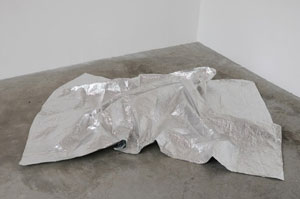
‘”The Floats”—or motorized mollusks—that artist Robert Breer took up producing again at the end of the 1990s, emerged in 1965. Primary shapes, neutral colours and, for the most recent, an industrial aspect, the Floats were then made with polystyrene, foam, painted plywood, and, more latterly, out of fibreglass. At first glance, these simple structures appear immobile. In fact, they are moving, imperceptibly, within the space they inhabit. They glide unbeknown to the visitor, following random paths that are interrupted by the slightest obstacle that they encounter. The Floats produce what should be named ”mechanical uncertainty”.’ — Musee d’art contemporain de Bordeaux
_____________
Unknown Floating Book (2009)
_____________
‘Ebru (water marbling) is the art of creating colorful patterns by sprinkling and brushing color pigments on a pan of oily water and then transforming this pattern to paper. The special tools of the trade are brushes of horsehair bound to straight rose twigs, a deep tray made of unknotted pinewood, natural earth pigments, cattle gall and tragacanth. It is believed to be invented in the thirteenth century Turkistan. This decorative art then spread to China, India and Persia and Anatolia. Seljuk and Ottoman calligraphers and artists used marbling to decorate books, imperial decrees, official correspondence and documents. New forms and techniques were perfected in the process and Turkey remained the center of marbling for many centuries. Up until the 1920’s, marblers had workshops in the Beyazit district of Istanbul, creating for both the local and European market, where it is known as Turkish marble paper.’ — turkishculture.org
_____________
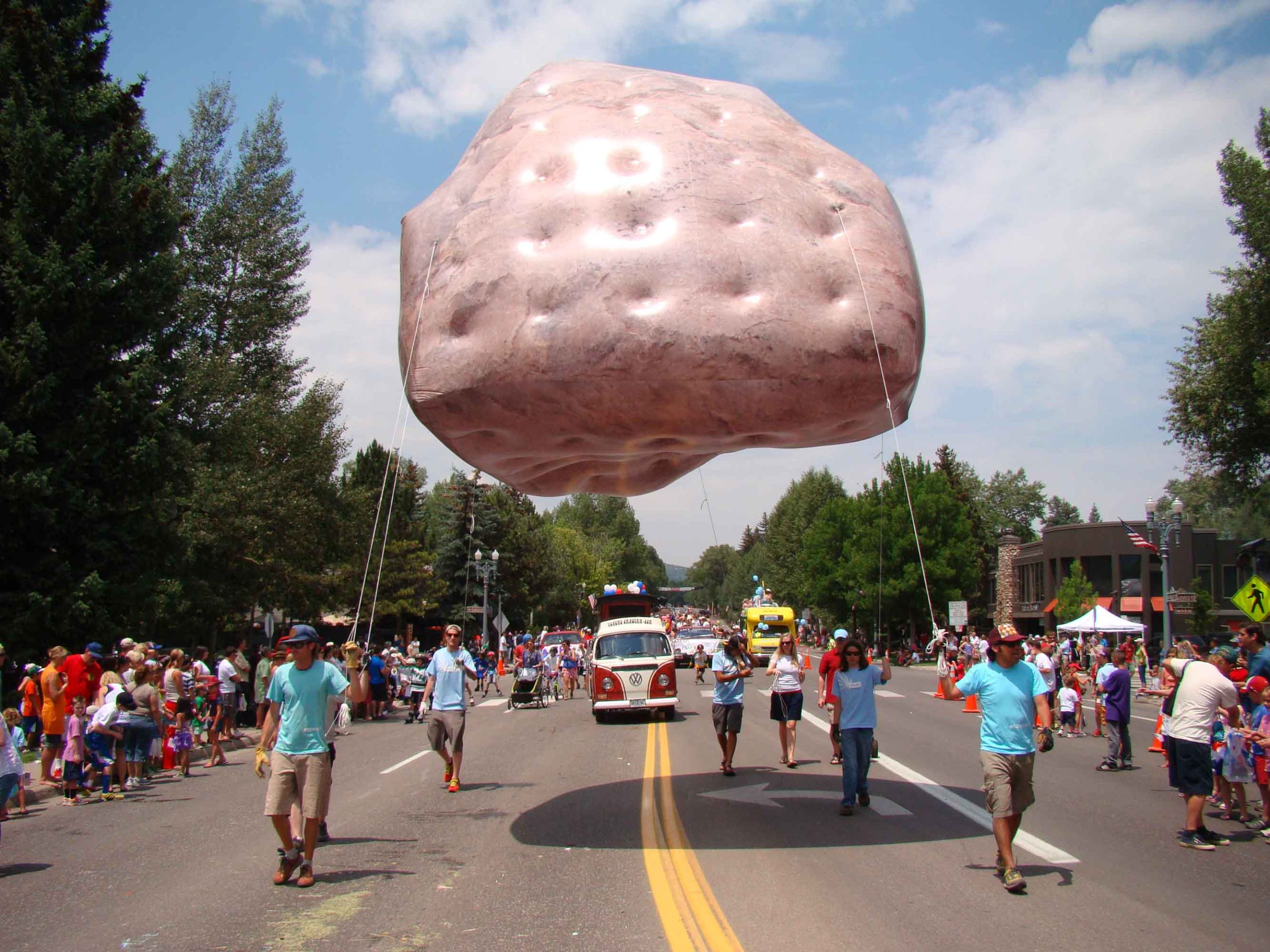

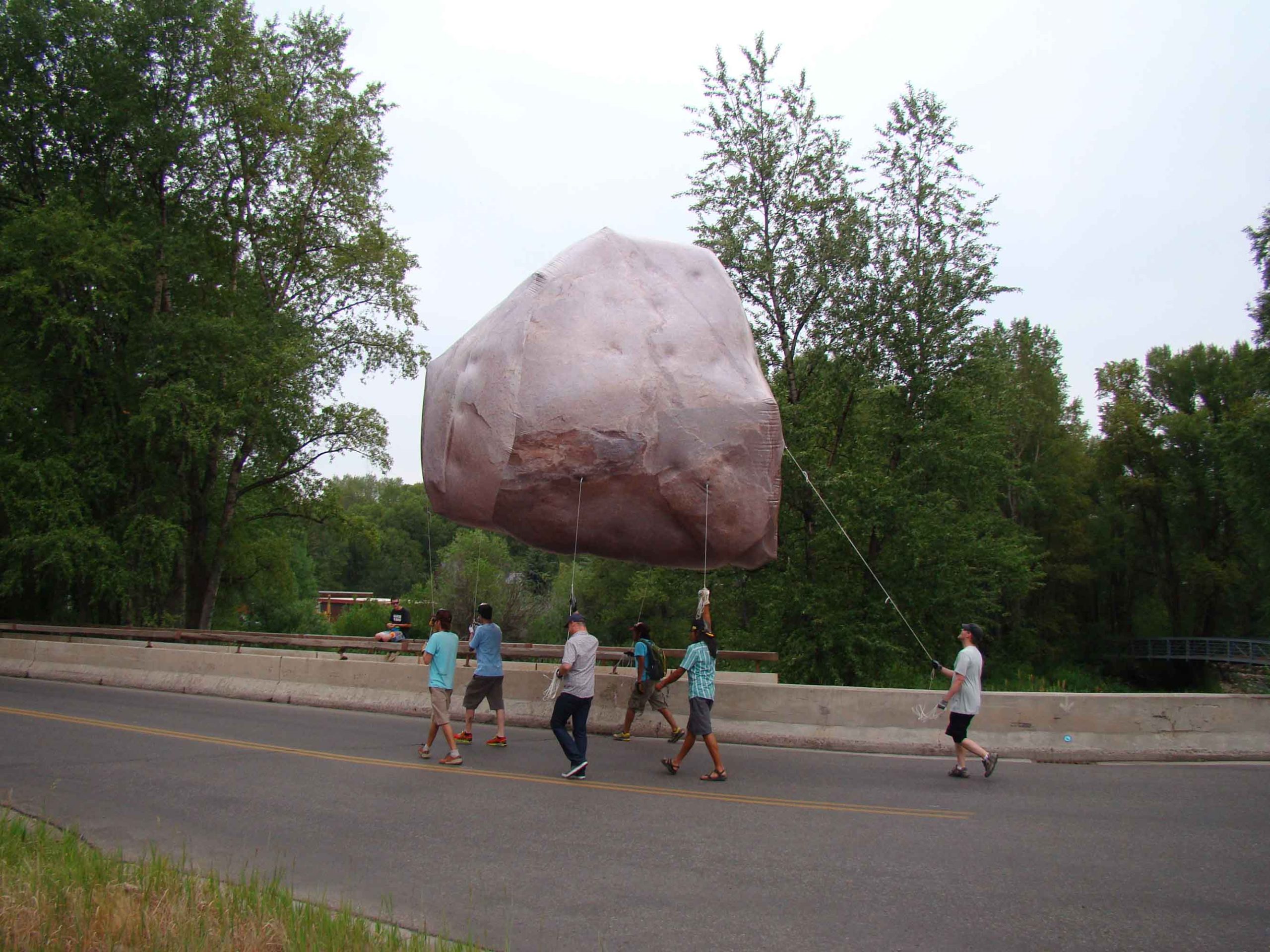
Mungo Thompson Levitating Mass, 2012
4th of July Parade Float
_____________



‘About 20 feet in diameter, artist Andrea Zittel’s “Indianapolis Island” is a fully inhabitable experimental living structure that examines the daily needs of contemporary human beings. “Indy island” is installed at the Indianapolis Museum of Art’s “100 Acres” Art and Nature Park, where over the course of four summers it will be occupied by commissioned “residents”. Each resident will will adapt and modifying the island’s structure according to their individual needs, while also performing hosting duties that will help facilitate public viewing of the work. Inaugural island residents Jessica Dunn and Michael Runge who lived on the structure over the summer of 2010 created a project called “Give and Take”.’ — zittel.org
_____________

“Dancing on the Ceiling: Art & Zero Gravity” is a unique group exhibition where contemporary artists explore and recreate the condition of weightlessness on earth. During this year’s event, Berlin-based sound artist Thom Kubli exhibited his new work called “FLOAT! Thinktank 21,″ which allows the users to experience zero gravity by soaking in salt water and listening to a new audio piece by Kubli for 5 minutes. This process is followed by 40 minutes of soothing silence. The installation piece features an egg-shaped flotation with a custom underwater sound system that plays audio recordings. According to Kubli, “Zero gravity can be read as a condition where prevailing reference models are suspended. “The condition of zero gravity might be evoked by willingly refusing a social and political model.”‘ — bornrich.com
____________


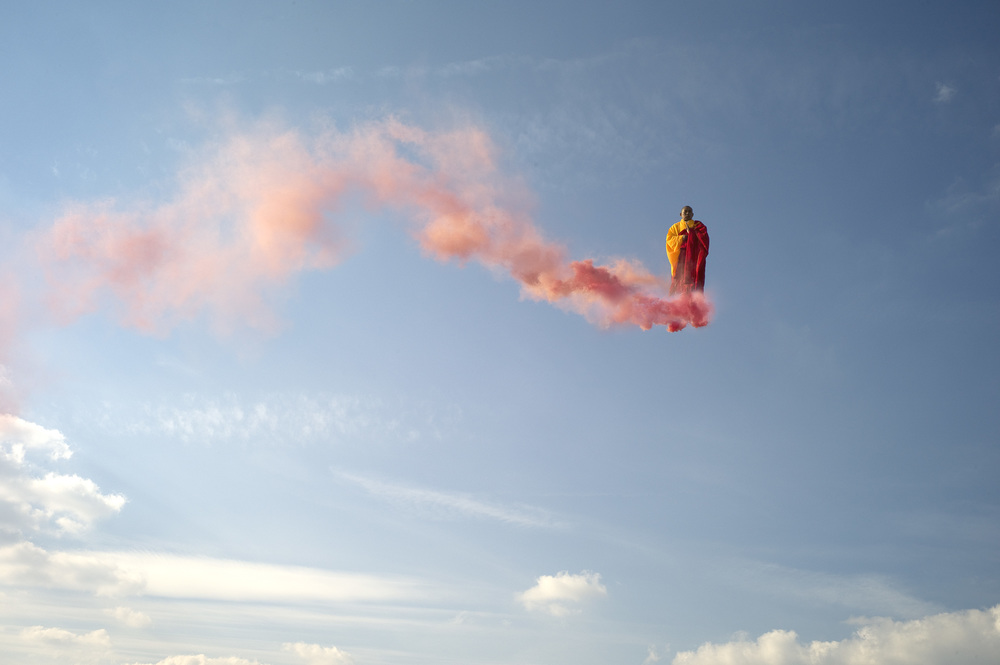
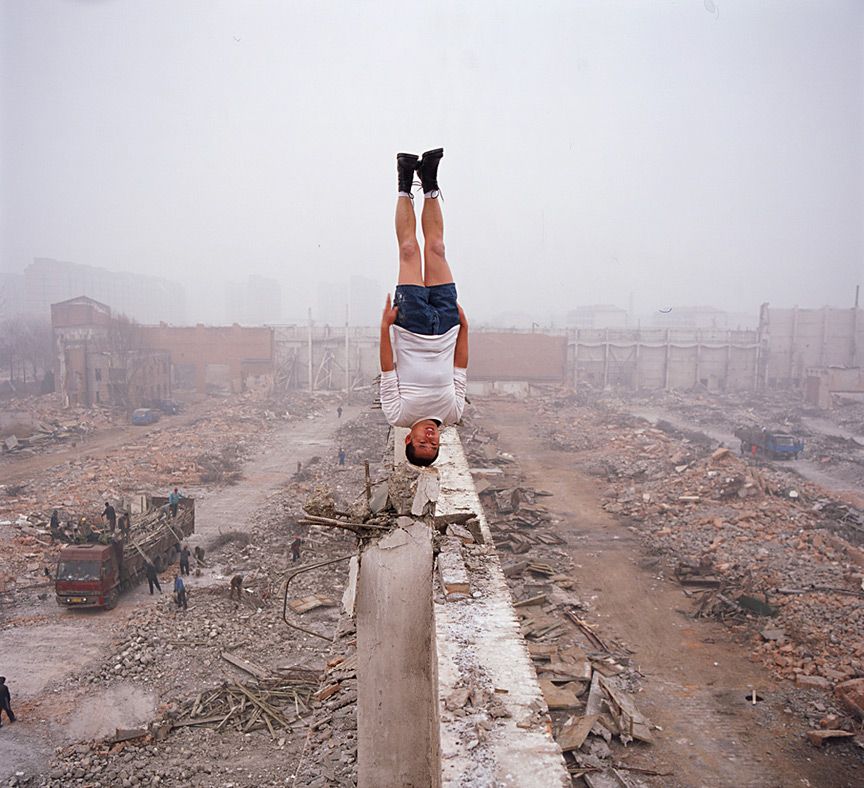
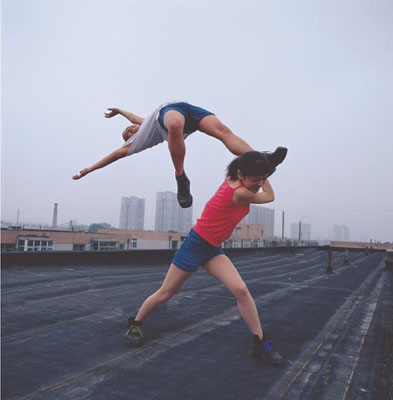
‘Li Wei is a contemporary artist from Beijing, China. His work often depicts him in apparently gravity-defying situations. Wei started off his performance series, ‘Mirorring’, and later on took off attention with his ‘Falls’ series which shows the artist with his head and chest embedded into the ground. His work is a mixture of performance art and photography that creates illusions of a sometimes dangerous reality. Li Wei states that these images are not computer montages and works with the help of props such as mirror, metal wires, scaffolding and acrobatics.
‘Many of Wei’s photos have layered meanings, demonstrating various aspects of Chinese society. In “Li Wei’s Body of Art” by Julie Segraves, Wei comments on his “Falls” series, in which he demonstrates the shock of societal progression. He notes: “If you picture someone falling to earth from another planet, there would really be no soft landing, whether the landing were in China or in another part of the world. This feeling of having fallen headfirst into the unknown and of having nothing firm under one’s feet is familiar to everyone. One doesn’t have to actually fall from another planet to feel that way.”‘ — Chaotic Earth
_______________
‘In Rafael Lozano’s “Tape Recorders”, rows of motorised measuring tapes record the amount of time that visitors stay in the installation. As a computerised tracking system detects the presence of a person, the closest measuring tape starts to project upwards. When the tape reaches around 3m high it crashes and recoils back.’ — bitforms gallery
____________


‘Trevor Paglen’s $1.5 million satellite has been lost in space—and Donald Trump’s 35-day government shutdown in January could be to blame. The pioneering artist and MacArthur Genius Grant recipient successfully launched his ambitious installation, Orbital Reflector, into space at the end of last year, but prolonged radio silence from the government during the unforeseen shutdown meant that engineers missed the window to complete the deployment of the work, a 100-foot-long diamond-shaped mylar balloon that could be tracked from earth.
‘Officials at the Nevada Museum of Art, which helped produce the work, confirmed in a statement that the work cannot presently be tracked.
‘The ambitious installation was in development for 10 years. It was launched into space in early December 3 on a SpaceX Falcon 9 rocket, along with 64 other satellites that had various utilities. The plan was for it to be delivered 350 miles into the thermosphere—one of the layers of Earth’s atmosphere—before inflating the balloon.
‘It was intended to inflate Orbital Reflector once it drifted away from the cluster of satellites it was released with in order to avoid collision. After that, it was meant to orbit Earth for a few months, where it would be visible from Earth, before being burned up by the atmosphere. A statement from museum officials explains that two unexpected events occurred early on in its journey. The first was that the US Air Force was unable to distinguish between the satellites because there were so many of them, so it was unclear when the package containing Orbital Reflector would be cleared to inflate.
‘The second was that the Federal Communications Commission “was unavailable to move forward quickly due to the US government shutdown.” Before the shutdown, the museum had been working with the FCC to release the balloon at the exact right time for a safe trajectory. Museum officials were waiting for a green light from the federal agency but all communications halted during the shutdown and, by the time communications resumed, the museum’s engineers had lost touch with the satellite.’ — artnet
____________


‘The Bellyflop Collection features Misha Kahn’s interpretations on poolside and outdoor entertaining accessories. With the Bellyflop Pool Float, playful meets, well… functional. If you’re into 10/10 bellyflops, that is (hint: we are). The PVC pool float with dichroic film was designed in New York, and made to create a splash everywhere.’ — ProspectNY
____________

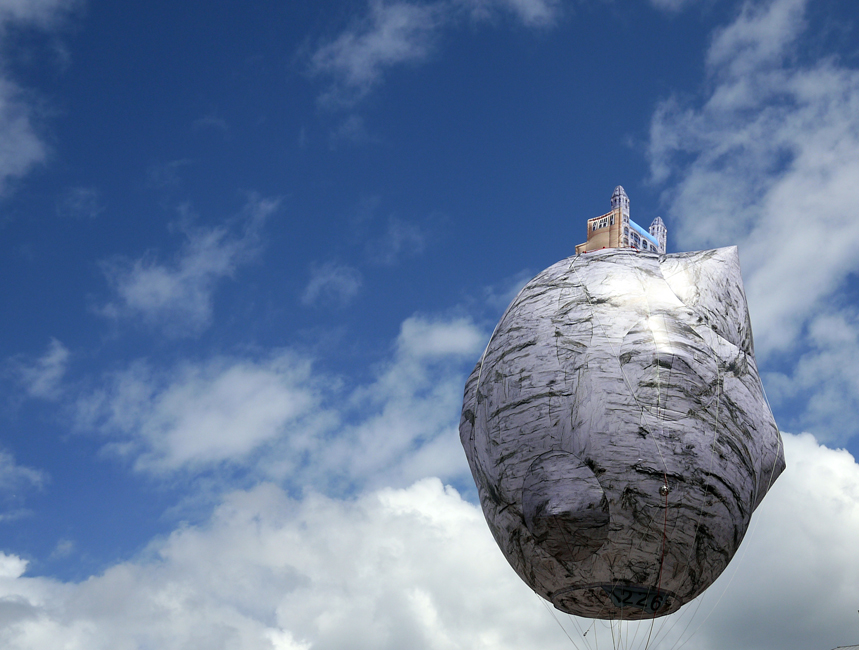
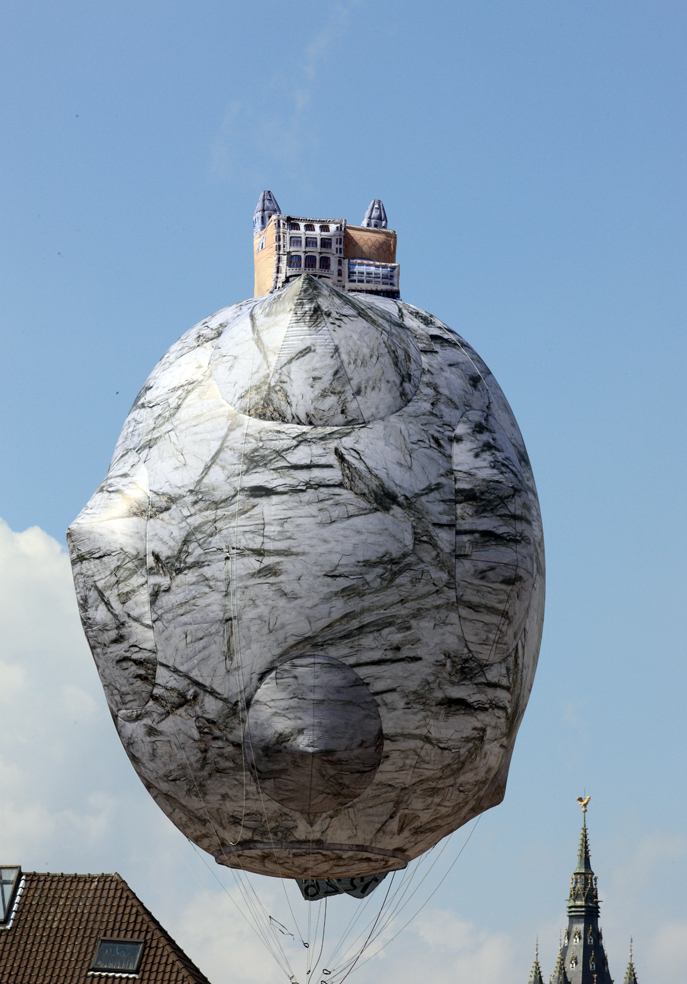
‘Ahmet Ögüt takes the socialist history of Ghent as the starting point for his contribution to TRACK, which is entitled ‘The Castle of Vooruit’. He concentrates on the Vooruit, the cooperative where the working-class people of Ghent assembled from the end of the nineteenth century until the early 1970s and which ran both a centre for festive occasions and a newspaper. Making reference to ‘Le Chateau des Pyrénées’ (1961) by the Belgian surrealist painter Rene Magritte, Ögüt is sending up a gigantic helium balloon in the shape of Magritte’s floating rock, launched near the Vooruit Arts Centre. He is replacing the mysterious castle on top with a replica of the Vooruit building. Ögüt captures the traces of a set of utopian social ideas in a single surreal image.’ — AOW
____________
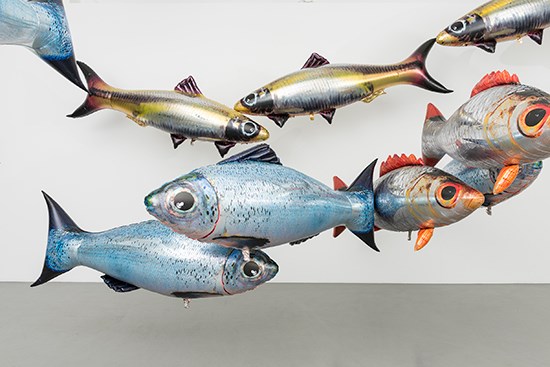
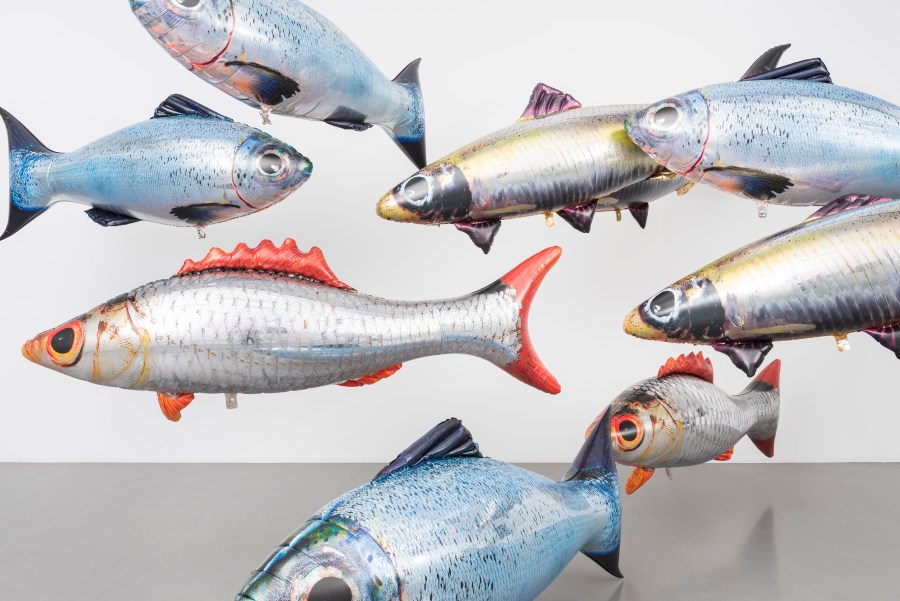
‘In 2018, the French artist Philippe Parreno exhibited his art in the Martin-Gropius-Bau in Berlin. In three consecutive rooms, he located his artwork entitled ‘My Room Is Another Fish Bowl’ with fish-shaped helium-filled Mylar® balloons floating in the space, following an imaginary circle, like real goldfishes do in a fish bowl. For visitors, walking in such a space among fish balloons behaving like real fishes is an overwhelming experience as people felt literally transposed into a fish bowl.’ — transsolar
____________
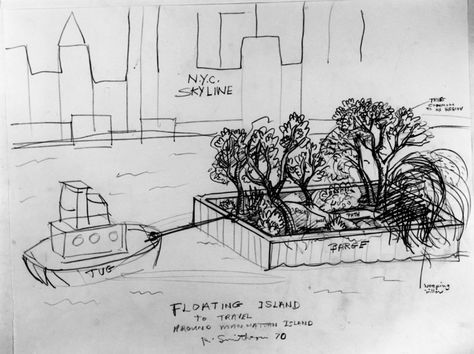


‘The island of Robert Smithson was formed over about a week, in a ragged-looking barge yard on Staten Island, shaped by a public art group, a landscape architect, a contractor, an engineer, a project manager and various other dedicated conceptual art workers using a 30-by-90-foot flat-decked barge, 10 trees, 3 huge rocks, a bunch of shrubs, rolls of sod, a whole lot of dirt and even more ingenuity.
‘The result, which will began a brief period of daily travels in 2005 along Manhattan’s shores, was much more than just a week’s work. It was the culmination of more than 30 years of sporadic efforts to build the ambitious floating artwork that Mr. Smithson sketched out in a rough drawing three years before he died in a plane crash in 1973, an image that showed a tiny, forested, man-made island being towed by tugboat with the city’s skyline in the distance.
‘Mr. Smithson tried to find backers to build the project, which he called “Floating Island,” during his lifetime but had no luck. In the years after his death, other admirers and artists also tried unsuccessfully to get the project going.
‘The Whitney Museum, which sponsored, “Floating Island” described it as a kind of “anti-‘Gates,’ ” referring to the saffron-colored extravaganza by Christo and Jeanne-Claude that had wound through Central Park during the previous winter.
‘In part this is simply because of the modest scale and cost of the island project – about $200,000, compared with the $21 million said to have been paid to create “The Gates.” It is also because, as public artworks, “The Gates” and “Floating Island” are like a split personality: “The Gates” invited public interaction and was, in effect, completed by it; the island, reflecting Smithson’s intellectual and generally chilly aesthetic, floats off at a distance, inaccessible, inhabited by no one.’ — NYTimes
_____________

‘Visitors to Art Central can see Desmond Leung’s VR ink painting titled The DAWN of INNER REALITY at the Parkview Gallery stand. The work uses VR technology in a painterly fashion to expand the concept of a technological singularity – a vast artificial intelligence that will change humanity beyond recognition.’ — Sedition

____________
‘Developed by New York graffiti artist, KATSU, who rose to fame in the 1990s by peppering the streets with his iconic skull tag, a spray-paint wielding drone is the latest step in his pursuit to paint bigger than anyone else in the city.
‘“Drones allow me to do what I had always yearned to do,” he told Bard College’s Centre for the Study of the Drone. “I’ve always looked at a building or looked at a canvas and stretched my arms out with my eyes. My eyes have always been able to reach it but my limbs have never been able to touch and reach these spaces.”
‘Lacking go-go-gadget arms, in the past he has used fire extinguishers to blast vast quantities of paint across huge areas, obliterating rivals’ puny tags with building-sized letters. Now he hopes his pet paint-spraying drone will let him get to places others can only dream of reaching.
‘“I have this little video game-inspired fantasy of lying in my bed, sending my drones out my bedroom window,” he said, “having them render my tags all over the city and then flying back home to me, like, in my bed.”’ — The Guardian
_____________
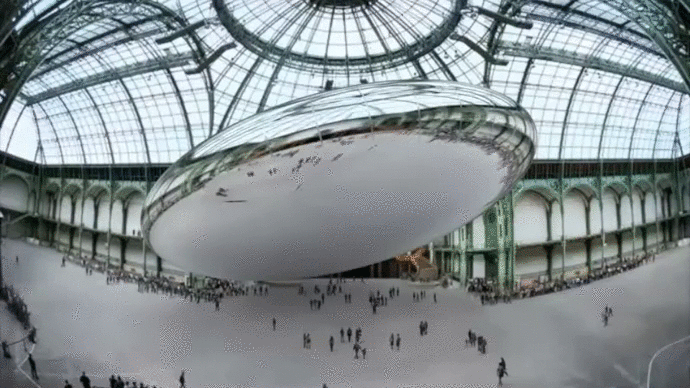
‘The ‘Pebble’ installation, created by Vincent Leroy, is a sensory experience. With the mirror effect, Vincent Leroy slows down time. The ground and the horizon slowly disappear. The inflatable structure’s mechanism, uses slow-rotating steel cables.’ — wordless Tech
_____________

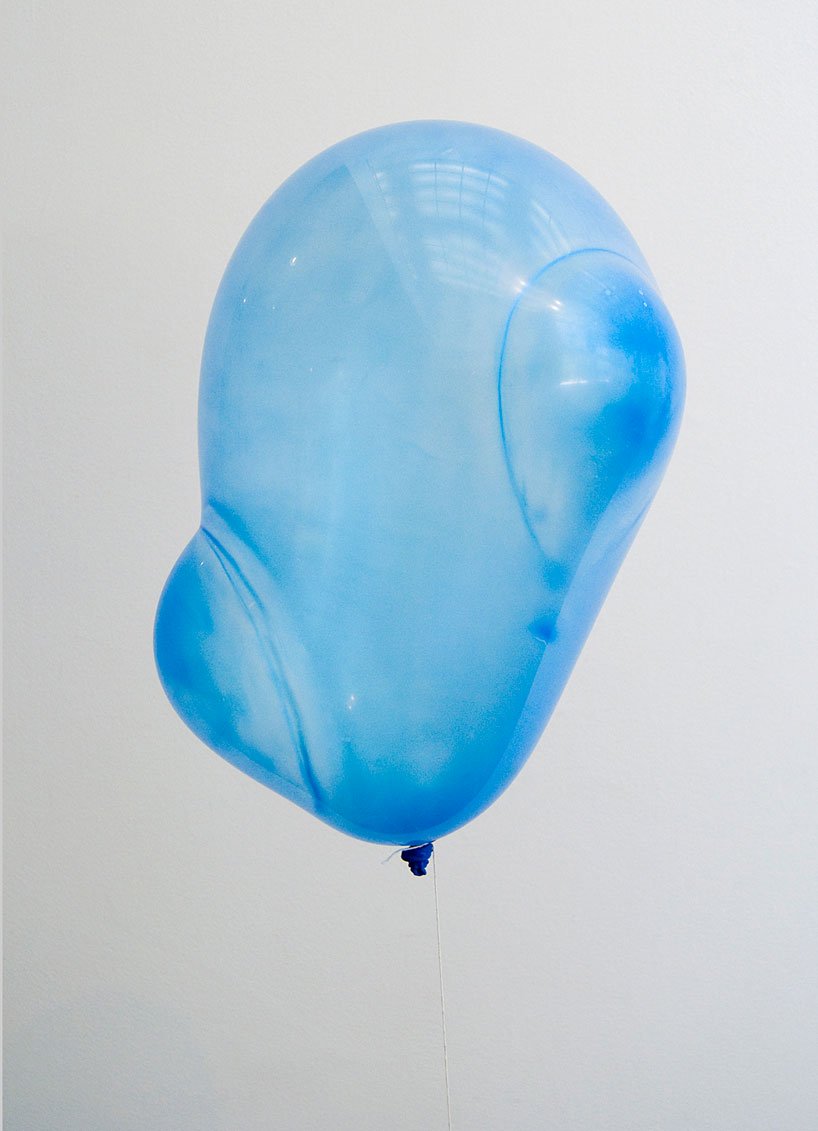
‘The Balloon Factory functions as a workspace and spectacle at once. Through it, the Object Design League explores methods of producing objects for consumption in a direct way, collapsing fabrication, distribution and purchasing into one space. The designers are replicating a hidden manufacturing process, but more importantly, taking ownership of it. Specially shaped formers dipped into liquid latex, hand-painted, and dried to create unique balloons—a portion of these inflated with helium was given to the public. By making a product by hand that is only known to be made industrially, they locate their practice on the fringes of mass production.’ — domus
_____________




‘Azuma Makoto is a Japanese flower artist who in 2014 sent a bonsai tree and a bouquet of flowers 30,000 metres into the sky above the Black Rock Desert in Nevada, USA. He attached his unusual space travellers to a specially-adapted high-altitude balloon and used high-speed cameras to record these extraordinary flights of fancy, creating 12,000 photographs in the process.’ — We Present
—-
*
p.s. Hey. ** David Ehrenstein, Hi. That’s a curious take on Davenport. I admire Pound’s work, oops. I’m in relative touch with Jim F., so, yes, I know about the housing struggle and his happy victory. ** JM, Hey, Josiah! Thank you, sir. Oh, I may have misphrased my new novel thing. There is potentially good news, but non-news or bad news are just as likely. The main thing is the novel has been stuck in this complicated logjam in the US for months, and my main hope is that the logjam will break one way or another any day now, via good news would be optimal, but hard to tell. But thank you for the enthusiasm. It’s super appreciated. So exciting that your new AS book is getting to be a done deal. Can’t wait, man. Enjoy the refining and editing as much as you can. Spoken as a big lover of editing and refining. All the very best! ** Bill, His essays are very, very pleasurable, yes. ‘Color Out of Space’ looks, from afar, to be … well, pretty much what you said. Watching Cage blow his gaskets aka act is usually worth whatever trip. Thank you, Bill. ** Steve Erickson, Hi. My novels have never gotten major attention, and I’m pretty accustomed to harsh judgements by now, so I don’t think that would be an issue for the new one. Plus, this one is a lot less potentially ‘controversial’ than some of my others. But we will see. I of course have followed that book’s publishing saga, and it’s a sadly predictable, overwrought mess just like pretty much everything else over in your neck of the woods these days. 2020 has officially begun! Everyone, Steve’s first reviews of the year are out and about, and you are cordially invited. Here he is on Marco Bellocchio’s THE TRAITOR, and here he is on Kitty Green’s THE ASSISTANT. Bon appétit! ** Misanthrope, Hi, G. Eyes on the deadline, maestro. I’m trying to just relax and enjoy the little spoils that come with senior discounted things, but I’m not there yet. ** Jeff J, Hi. Yeah, I just discovered the ‘Reader’ myself shortly ago. I think the history re: his stuff and blog sounds right. Hm, I … don’t think I have an especially favored phase of Armantrout’s work off the top of my head, no. If I went back into the work’s trajectory, I might. Ah, great that Stephanie got the Hollis Frampton essays book! I love that book. It was big for me. And he’s a great hero of mine, as you know. Best Tuesday ever to you! ** Sypha, Hi, James. ** Okay. Today: things that float. See you tomorrow.




 Now available in North America
Now available in North America 
Hi Dennis! I’ve just finished reading ‘The Sluts’ for a seminar. I was wondering why you chose a gay male escort website in particular for the setting of the novel? I identify as female and am quite squeamish about violence, but I was surprised at how gripped I was by the book – why is the absence of non-male characters (with the exception of ‘Elaine’) important? I guess I’m wondering about the significance or implications of gender in a virtual world where identity is so uncertain. Thanks so much!
Here’s a perfect “Floats” for ya: The st scene of “Skidoo”
Hollis Frampton was an interesting filmmaker, but sucha pompou ass of a person. However I grant him absolution for decimating John Simon at a legendary new York Film Festival press conference back in 1970 when “orns Lemma” was screened.
Now here’s a real find: A complete performance of the Original Chicago Second City from 1960 An hour and a half’s worth of the greats: Alan Arkin, Barbara Harris, Severn Darden, Paul Sand, Eugene Troobnick, Andrew Duncan and Mina Kolb. Most are gone now, alas. But Alan Arkin is as big a star as ever, Mina Kolb is on “Curb Your Enthusiasm” and Paul Sand (who the husband had a brief affair with back in the day) performs off and on at a club out near the beach in Venice (Paul is now 88 and his real last name is Sanchez)
Hello Dennis,
I’m one of Diarmuid Hester’s students, and my question is: why did you write the sluts, what were you aiming to do?
All best, Tom
Hi Dennis, I’ve also been reading ‘The Sluts’ for a seminar. I’ve been thinking about the porousness of boundaries in the novel (real/fantasy, self/other, bodied/disembodied), and I would be interested to know your thoughts on whether the act of reading constitutes a kind of participation—a further crossing of a boundary?
Hello Dennis! I’m also a literature student and was wondering if I could ask you a question about ‘The Sluts’. What is your opinion on the future of virtual communication? Are you more excited by its potential impetus for creating new forms of writing or depressed by the potential for miscommunication and lack of accountability? Thank you, I’m really looking forward to hearing from you.
Hi Dennis, I’ve been reading ‘The Sluts’ for a seminar on Contemporary Literature. I’ve been thinking about the porousness of boundaries in the novel (real/fantasy, self/other, bodied/disembodied), and I would be interested to know your thoughts on whether the act of reading constitutes a kind of participation—a further crossing of a boundary?
hey dee, i love things that float, great day. the smithson float is so nice wow. i wish that floating magnetic hoverboard technology was easily accessible, i’d love to float some sculptures. for west germany, you absolutely may pack the trip a little with theme parks, i’m very very into that. what date does the charles ray show open? wondering if it’s opened when we’re there, that would be great, assuming it’s in or near paris. oh, when we were in paris last you mentioned some work outside the city, some kind of land art thing that sounded incredible… it was by a man? sorry that’s so vague. if you have any idea what i mean, was that just there then or a permanent installation? my tutorial last week was good, it was useful which is the best, plus as a bonus my advisor was really into my new drawings. and she never really says she likes anything (which is fine), so that was fun! didn’t do much this weekend. my roomie hanna’s boyfriend was visiting from denmark plus a friend of theirs slept on the couch for a few nights on her way to working at a ski resort a few hours from here, so we had dinner, hung out. today i helped my other roomie iris with some stuff at school since she’s graduated and can’t really access stuff anymore. and i’m catsitting for ottar & øyvind’s two cats (Sparkles & Snoopy) so we went by there to feed them and hang out a little. now i’m in my studio, about to find out if i have the energy to do some drawing. how was your weekend plus monday and tuesday? how’s yury and how’s zac? give zac my love! xxx
Hi Dennis! I just finished reading ‘The Sluts’ for a seminar. I was wondering why you chose a gay male escort website in particular for the setting of the novel? I identify as female and am quite squeamish about violence, but I was surprised at how gripped I was by the book – why is the absence of non-male characters (with the exception of ‘Elaine’) important? I guess I’m wondering about the significance or implications of gender in a virtual world where identity is so uncertain. Thanks so much!
Hi, I’m part of Diarmuid Hester’s Cambridge seminar group and I was just wondering whether ‘The Sluts’ was difficult to write?
Best wishes
Hi DC,
Ah! Fujiko Nakaya! Hadn’t you and Zac planned to do a documentary on her at some point?
Just checking in to test the comments are posting ok, a couple of students have had issues…
Diarmuid xx
Hi Dennis, I’m another of Diarmuid’s students. I was wondering how you would respond to readers saying they found The Sluts too upsetting to finish. Sometimes during gruesome or disturbing scenes in TV and film we might close our eyes, but this is hard to do when violence and perversion occur throughout the whole book. Do you think it’s important for squeamish readers to make their way through the book (particularly because violence and exploitation does really occur in the prostitution/porn industry around the world), or would you be understanding if they simply declined to read it? – Rebekah
Hi Dennis!
I have read ‘The Sluts’ for a seminar. I can’t seem to see any of the other replies so I’m sorry if this has already been asked.
Since you wrote ‘The Sluts’ more and more forms of online interaction have developed with a particular focus on visuals, Instagram and Snapchat being prime examples. If you had written the novel now do you think you would have incorporated any new online forms? A lot of the content in your novel is very violent and graphic, do you feel the expression of it through words is a reductive mediation or do you see these passages as equating a video or image?
Hi, I’m also part of Diarmuid Hester’s seminar group. Regarding The Sluts, I would like to ask: How do you feel about this novel being taught as part of a ‘Contemporary Writing’ paper for an undergraduate course in English? Is this kind of academic reception and study of the book something you are pleased or concerned about, or does it in fact not matter to you? Why?
Thank you for your time!
Hi Dennis. I’ll contribute some floating pieces made by my friend Ben Beres (with his collective SuttonBeresCuller):
Small Moons: http://suttonberesculler.com/portfolio/small-moons/
The Island: http://suttonberesculler.com/portfolio/the-island/
Ben may be best remembered on the blog as the guy who puked bananas on stage with the band Raft of Dead Monkeys (subject of my movie “The Complete History of Seattle,” which you hosted a couple years ago). His artwork usually makes me laugh, which is sort of the highest compliment I feel capable of giving anything…
Hi Dennis – I am in Diarmuid Hester’s contemporary seminars and my question about ‘The Sluts’ is regarding its form, which seems to be such a massively foregrounded aspect of the text. I was wondering if you could elaborate at all in thinking about communication and digital spaces. We receive the text from a range of people all of whom communicate digitally with each other rather than with us, so there’s this indeterminacy at the level of our reading, where we intrude upon but are also sort of complicit in what happens. But then these digital spaces are used to think about incredibly physical desires and urges, so there’s a dichotomy there too? And I just wondered if you could expand on that at all, about our need for physical contact/intimacy, and how the methods we create in order to seek it out seem to negate this. Sorry if someone else has also asked about this, and thanks very much for your reply!
Jabin
Hi Dennis,
I loved ’the Sluts’ – it was unlike anything I had read before. It was fascinating, horrifying and at points very sad. I was wondering why you are drawn to such a setting. What is it about the platform of the Internet/online communities that suit the subjects of sex, violence and fantasy for you? Are there other cyber spaces or communities that you would like to explore yourself, or see fiction explore more?
Also, on an unrelated note, reading your book made me think of a story woven into one of Deerhunter’s songs called ‘Helicopter’. In the liner notes of the album, Cox writes about the ‘true’ story that inspired the lyrics: a young male escort in Russia called Dima who disappears into increasingly disturbing worlds and whose death was being investigated by a gay journalist. I’ll bet Bradford Cox is a fan.
Hi Dennis, I have been reading The Sluts for Diarmuid Hester’s seminar on the book. I’d be interested to know if, when you were writing, you had a particular approach for the descriptions of sexual violence, and if you were thinking about a reader response — a certain level of complicity perhaps or a balance between involvement and detachment, or something completely different?
I hadn’t seen your blog before reading the book and it’s an experience in itself to move from the world of The Sluts into this world that looks in so many different directions. Thank you for it all!
I always liked this floating ping-pong ball by Damien Hirst, from back when he was good and had the 90s zeitgeist as his personal plaything. We attended the same Leeds art college a generation apart and his aura was still in the building.
I’m leaving to see THE COLOR OUT OF SPACE in 20 minutes. I have very high hopes!
I downloaded the new Destroyer album this afternoon but haven’t had time to listen yet. Have you?
The current controversy over AMERICAN DIRT surprised me because I thought people had stopped caring about books that much, honestly. It’s one thing for YA Twitter to be a hive of “cancel culture,” but this book has become the subject of multiple NY Times op-eds, etc. I wish the book sounded the slightest bit interesting, rather than a formulaic potboiler. But at the same time, I’m bothered by the way so much discourse about it has revolved around whether it’s OK for an author who’s 1/4th Puerto Rican to write about Mexicans, to call herself Latina when she identified as white a few years ago, etc. It’s perfectly possible for a writer living in Mexico to compose a book that plays into negative North American stereotypes about the country. If Bret Easton Ellis returned to fiction with AMERICAN PSYCHO 2: THE CONTINUING ADVENTURES OF PATRICK BATEMAN, would anyone care?
It;s also perfectly possible that she’s a grafter of the worst sort.
That boat at the beginning is pretty awesome. And some of those Li Wei photos are very nice. Reminds me a bit of this old favorite from Kerry Skarbakka:
https://www.skarbakka.com/wp-content/uploads/2019/09/Naked.jpg
I’ve never met Guy Davenport in person, but there’s plenty of humor in some of his fiction that I’ve read.
And yes, there’s lots of gasket-blowing from Cage in Color Out of Space, heh heh.
Bill